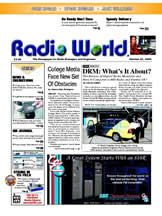
 |
|
|||||||||
|
|
 |
||||||||
 |
The Ocean is Cruel to Broadcasters Dick Witkovski Part II by Mark Persons |
Radio
World Article September 3, 2015 |
|
Caroline's anchor chain broke in 1980, and the ship sank, ruining all the equipment aboard. Radio engineer and part time announcer Peter "Chicago" Murtha was sent to the United States to pick up a replacement transmitter, again supplied by Witkovski. It was a 50 kW RCA Ampliphase, which could modulate to 150 percent positive. This was a real plus to get a loud sound on the dial, Witkovski notes. The new Radio Caroline ship was equipped with a 300-foot tower, taller than the ship was long. Tons of ballast were used near the ship's keel to counterbalance and stabilize the pendulum effect of the tower. Radio Caroline was back on the air in 1983 at 963 kHz, later heard on 558 kHz. Then another disaster struck. In 1991, the ship's anchor chain broke again and she drifted near shore, grounding, and this time almost sank. This chapter of the station's history ended, though today you find Radio Caroline on the Web at http://carolinestreams.weebly.com. OFFSHORE VS. PIRATES Witkovski takes pains to differentiate offshore vs. pirate broadcasting. Offshore broadcasters operate in international waters. In the early 1960s, he said, offshore broadcasting became a method for commercial radio to make a breakthrough into Europe and Scandinavia, where no commercial frequencies were available and there were no country licenses to apply in international waters; the law did not prohibit broadcasting from international waters. Pirates, on the other hand, operate illegally from within the countries to which they broadcast.
Witkovski says this type of broadcast was experimental, and he found it to be an adventure, an opportunity to expand commercial radio to countries where that kind of broadcasting was not available. The experience was grounded in the hope that all governments would someday issue commercial licenses because there was and is a need for it. Mark Persons, CPBE, has more than 30 years' experience and has written numerous articles for radio publications. He uses amateur call sign W0MH; his website is www.mwpersons.com.
|
September 4, 2015, e-mail: THANK YOU Sir, for the article on Radio Caroline, in Radio World Magazine. I was stationed in Bamberg Germany in the U.S. Army in the 1960s at a missile site. Anyhow, Yea, a LOT of GI's listened to that signal, more than the Armed Forces Network! Again, THANKS. Retired broadcaster Fred Shetler, Port Royal, Pennsylvania. |
|
|
|
Questions? Email Mark Persons: teki@mwpersons.com |
|
.